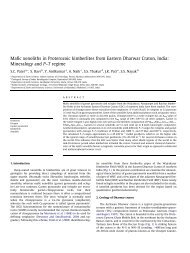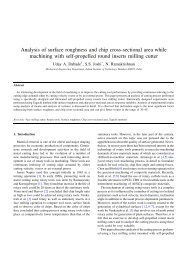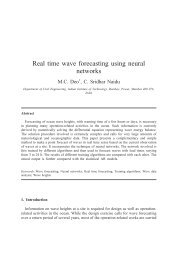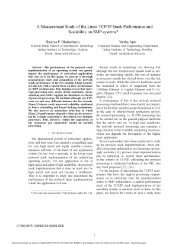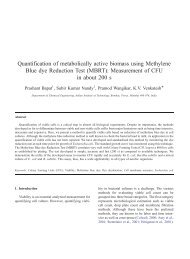Infrared signature studies of aerospace vehicles - DSpace at IIT ...
Infrared signature studies of aerospace vehicles - DSpace at IIT ...
Infrared signature studies of aerospace vehicles - DSpace at IIT ...
You also want an ePaper? Increase the reach of your titles
YUMPU automatically turns print PDFs into web optimized ePapers that Google loves.
Spectral Radiance (W/m 2 ⋅Sr -1 ⋅μm -1 )<br />
10<br />
5<br />
0<br />
Horizon = 0°<br />
15°<br />
30°<br />
5 10 15<br />
λ (μm)<br />
20 25<br />
Vertical p<strong>at</strong>hlength:<br />
Zenith<br />
Zenith=90°<br />
because <strong>of</strong> its vibr<strong>at</strong>ional band; but <strong>at</strong> this wavelength,<br />
the spectral emissive power <strong>of</strong> the <strong>at</strong>mosphere<br />
is negligible [51]. Berger’s model predicts<br />
<strong>at</strong>mospheric IR-radiance accur<strong>at</strong>ely, except in<br />
16–20 mm band (which is not <strong>of</strong> significance for IR<br />
<strong>sign<strong>at</strong>ure</strong> <strong>studies</strong>). Fig. 6 shows the contrast between<br />
aircraft and background (predicted using Berger’s<br />
model) IR radiance in dry mode, for tropical and<br />
mid-l<strong>at</strong>itude summer <strong>at</strong>mospheric conditions. The<br />
neg<strong>at</strong>ive radiance in some bands is because <strong>at</strong>mospheric<br />
IR radiance (estim<strong>at</strong>ed from Berger’s model)<br />
exceeds the aircraft IR radiance. The positive<br />
contrast is higher for mid-l<strong>at</strong>itude summer than<br />
R e<br />
H <strong>at</strong>m<br />
EARTH<br />
R e + H <strong>at</strong>m<br />
Atmosphere containing<br />
IR-radi<strong>at</strong>ion<br />
particip<strong>at</strong>ing gases<br />
ARTICLE IN PRESS<br />
Horizontal p<strong>at</strong>hlength:<br />
Horizon<br />
Fig. 5. Spectral sky radiance from zenith to horizon: (a) spectral<br />
radiance <strong>of</strong> sky for mid-l<strong>at</strong>itude summer <strong>at</strong>mosphere (after [51])<br />
and (b) Illustr<strong>at</strong>ion <strong>of</strong> p<strong>at</strong>h-lengths <strong>of</strong> horizontal and vertical<br />
beams.<br />
Spectral Contrast (W⋅m -2 ⋅Sr -1 ⋅μm -1 )<br />
10<br />
6<br />
2<br />
-2<br />
-6<br />
tropical <strong>at</strong>mosphere but neg<strong>at</strong>ive contrast is higher<br />
for the l<strong>at</strong>er, because the background IR-radiance is<br />
higher for the l<strong>at</strong>er. The highest contrast is in<br />
8–12 mm band due to rear fuselage skin contribution.<br />
The conjug<strong>at</strong>e role <strong>of</strong> <strong>at</strong>mospheric transmission<br />
<strong>of</strong> IR radi<strong>at</strong>ion and background IR radiance (using<br />
Berger’s model), on aircraft susceptibility against<br />
SAM, was examined [51]. It was found th<strong>at</strong>:<br />
(i) when the engine tailpipe is not visible, aircraft<br />
IRSL is prominent in the 3.24–4.18, 4.50–4.93, and<br />
8.20–11.80 mm bands; (ii) when the engine tailpipe is<br />
visible, aircraft IRSL is also significant in the<br />
1.95–2.50 and 2.92–3.20 mm bands; (iii) <strong>at</strong>mospheric<br />
IR radiance is dominant only in 8–12 mm band and<br />
is insignificant in lower wavelength bands; and<br />
(iv) the aircraft rear fuselage is a prominent source<br />
<strong>of</strong> IRSL in the 8–12 mm band. Therefore, an aircraft<br />
is susceptible from the front to all-aspect IR-missiles<br />
in the 8–12 mm band.<br />
3.4. Role <strong>of</strong> earthshine in IRSL<br />
Mid-l<strong>at</strong>itude Summer<br />
Tropical<br />
-10<br />
0 2 4 6 8 10<br />
λ (μm)<br />
12 14 16 18<br />
227<br />
Fig. 6. Spectral contrast between aircraft and background IR<br />
radiance (after [51]).<br />
Earthshine is the IR radiance from the earth’s<br />
surface (determined by ground temper<strong>at</strong>ure and<br />
emissivity) th<strong>at</strong> is reflected from the aircraft surface<br />
and then collected by IR-detector. Its estim<strong>at</strong>ion is<br />
important in the 8–12 mm band for aircraft flying <strong>at</strong><br />
low altitude (typical <strong>of</strong> a bombing mission), and its<br />
effect is insignificant in the 3–5 mm band [57]. As<br />
shown in Fig. 7, the vari<strong>at</strong>ion <strong>of</strong> IR contrast with<br />
emissivity in the 3–5 mm band is almost the same<br />
with and without the effect earthshine [57]. In both<br />
bands, the slope is higher without earthshine;<br />
because the earthshine contribution to IR contrast<br />
increases with decreasing emissivity. This dependence<br />
<strong>of</strong> the earthshine contribution is the opposite<br />
20



